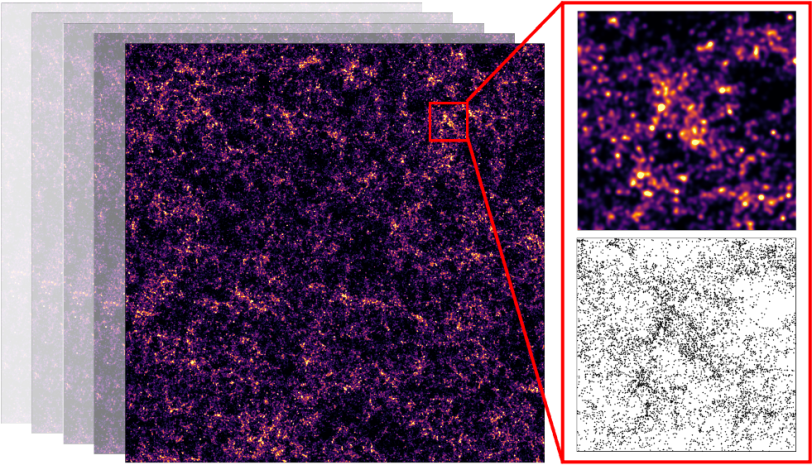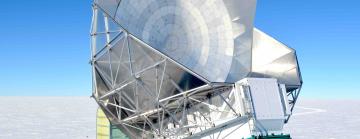The universe’s missing teenage pictures
Line intensity mapping measurements taken with a new type of instrument will allow astrophysicists to study galaxies too far away for traditional survey methods.
By Chris Patrick
Astrophysicists can use measurements of the cosmic microwave background, radiation formed 380,000 years after the Big Bang, to understand what the universe was like in its infancy. And by observing light emitted from galaxies close enough to Earth for telescopes to detect, scientists can catalog individual galaxies to learn about their distribution.
“How clumpy matter is in the universe tells us all sorts of interesting physics,” said Kirit Karkare, associate scientist at the Department of Energy's SLAC National Accelerator Laboratory and a senior member of Stanford University and the SLAC/Stanford Kavli Institute for Particle Astrophysics and Cosmology (KIPAC). Physicists can use the large-scale structure of the universe to learn about dark energy, dark matter, inflation and neutrinos.
Beyond a few billion years ago, however, galaxies are too distant for even the most powerful telescopes to resolve. With current techniques, scientists can only see five to ten percent of the volume of the entire universe, which is about 14 billion years old.
“We want to measure the full volume of the universe because that gives us the best precision on cosmological physics,” Karkare said. “It turns out that just because some galaxies are faraway and faint, it doesn't mean that you can't detect them. We just need a new technique to see the teenage universe, if you like.”
He believes that the technique may be line intensity mapping (LIM). With his co-principal investigators, Peter Barry at Cardiff University and Adam Anderson at DOE's Fermi National Accelerator Laboratory, Karkare is developing a new kind of detector that will use LIM to map galaxies that are too far away for traditional surveys.
“It’s really fun to be breaking new ground,” Karkare said. “If we're right, it means that we’ll have an observational technique that can allow us to map out basically the entire history of the universe and extract the maximum amount of cosmological information that we can.”
Smeared measurement, same physics
Instead of using a high-resolution telescope to pinpoint individual galaxies, LIM uses a low-resolution telescope to study the sum of radiation emitted from a collection of galaxies. As a result, intensity mapping images appear smeared compared to traditional galaxy survey images. Researchers can still use them to figure out the clumpiness of the universe: areas with more galaxies are brighter, areas with less are dimmer.
“It turns out that this line intensity image contains all of the relevant cosmology and physics as the traditional galaxy survey image,” Karkare said.
Combining these smeared images with the color of the light tells astrophysicists how far away the aggregates are, just as in traditional surveys, to map clumpiness in three dimensions.
“If you don't need information about the details of individual galaxies, this technique is likely the most efficient way to map the clustering of those galaxies and the large-scale structure of the universe over a very large volume. The evolution of this map holds the primary information about fundamental physics from the sky, including the nature of dark energy and inflation,” said Risa Wechsler, director of KIPAC and Humanities & Sciences Professor and Professor of Physics and of Particle Physics and Astrophysics at Stanford University and SLAC.
LIM can be applied to any wavelength of light, Karkare said, and he and colleagues will detect in the millimeter wavelength range because faraway galaxies are bright in this range.
Early galaxies are dusty, ideal conditions for star formation. The light emitted by these stars is absorbed by the dust and then the dust re-radiates it at longer wavelengths. As this light travels to Earth, it gets stretched to even longer wavelengths, and is visible from ground-based observatories at wavelengths of about a millimeter.
But this signal is still extremely weak.
“It takes years and years of averaging observations of a seemingly blank patch of sky before you can tease out very, very faint signals,” Karkare said.
While other experiments are taking LIM measurements at millimeter wavelengths, the new type of instrument Karkare is helping develop, the South Pole Telescope Summertime Line Intensity Mapper (SPT-SLIM), will make this type of measurement with more sensitivity than ever before to access the universe’s mysterious middle years.

Miniature detectors maximize sensitivity
Instead of using one large spectrometer as usual, SPT-SLIM will feature 18 mini spectrometers that have each been printed onto a silicon wafer. Because the detectors are smaller, more can be packed into the instrument, making it sensitive enough to detect faint millimeter-wave light from distant galaxies. Karkare believes SPT-SLIM will be able to detect galaxies that formed 2.5 billion years after the Big Bang.
Members of the SPT-SLIM team have been working on SPT-SLIM’s detectors at the University of Chicago since 2021. These detectors operate at temperatures close to absolute zero, so colleagues at Fermilab are building a cryostat to keep them cool.
Next, the team will install the detectors, which are housed in a compact three-foot-tall cylinder with the cryostat, in the South Pole Telescope, where it will collect data during Antarctica’s summer season this year.
“The South Pole is paradise for an experimental cosmologist,” Karkare said. Antarctica is especially ideal for millimeter-wave measurements, whose faint signal is blocked by atmosphere and water vapor. The South Pole is almost 10,000 feet above sea level, which means there’s less atmosphere in the way, and water freezes out of the air.
Once the team demonstrates that SPT-SLIM works, they’ll begin to scale up to a larger instrument featuring 10 times the detector count. This enhancement will hopefully allow future experiments to reach galaxies formed 500 million years after the Big Bang.
“SPT-SLIM will be able to serve as a pathfinder for something much larger that we could do in the next decade,” Wechsler said.
Karkare plans to use SLAC’s Detector Microfabrication Facility, which is currently under construction, to make these tiny detectors more easily.
“I'm really excited to take advantage of this new facility to scale up our detector fabrication,” Karkare said. Although he’s the only person working on SPT-SLIM at SLAC for now, Karkare plans to start an intensity mapping group at the lab. He’s also excited to work with Wechsler and other colleagues at KIPAC and SLAC focused on traditional galaxy surveys, such as the Vera C. Rubin Observatory Legacy Survey of Space and Time, to get the most out of SPT-SLIM’s maps.
“One of the most exciting aspects of this is actually the complementarity between these different techniques and how we’ll put all this together to get the best, most precise, most accurate picture of what the universe is doing over the largest possible volume,” Wechsler said.
And SPT-SLIM is more than just a way to look at previously inaccessible patches of universe. It’s also a way to remember a colleague. The concept for this instrument originated while Karkare was working in the lab of University of Chicago astronomer Erik Shirokoff, who passed away in January.
“We all really miss him,” Karkare said. “So we view deploying SPT-SLIM as one way to honor his legacy.”
For questions or comments, contact the SLAC Office of Communications at communications@slac.stanford.edu.
About SLAC
SLAC National Accelerator Laboratory explores how the universe works at the biggest, smallest and fastest scales and invents powerful tools used by researchers around the globe. As world leaders in ultrafast science and bold explorers of the physics of the universe, we forge new ground in understanding our origins and building a healthier and more sustainable future. Our discovery and innovation help develop new materials and chemical processes and open unprecedented views of the cosmos and life’s most delicate machinery. Building on more than 60 years of visionary research, we help shape the future by advancing areas such as quantum technology, scientific computing and the development of next-generation accelerators.
SLAC is operated by Stanford University for the U.S. Department of Energy’s Office of Science. The Office of Science is the single largest supporter of basic research in the physical sciences in the United States and is working to address some of the most pressing challenges of our time.






